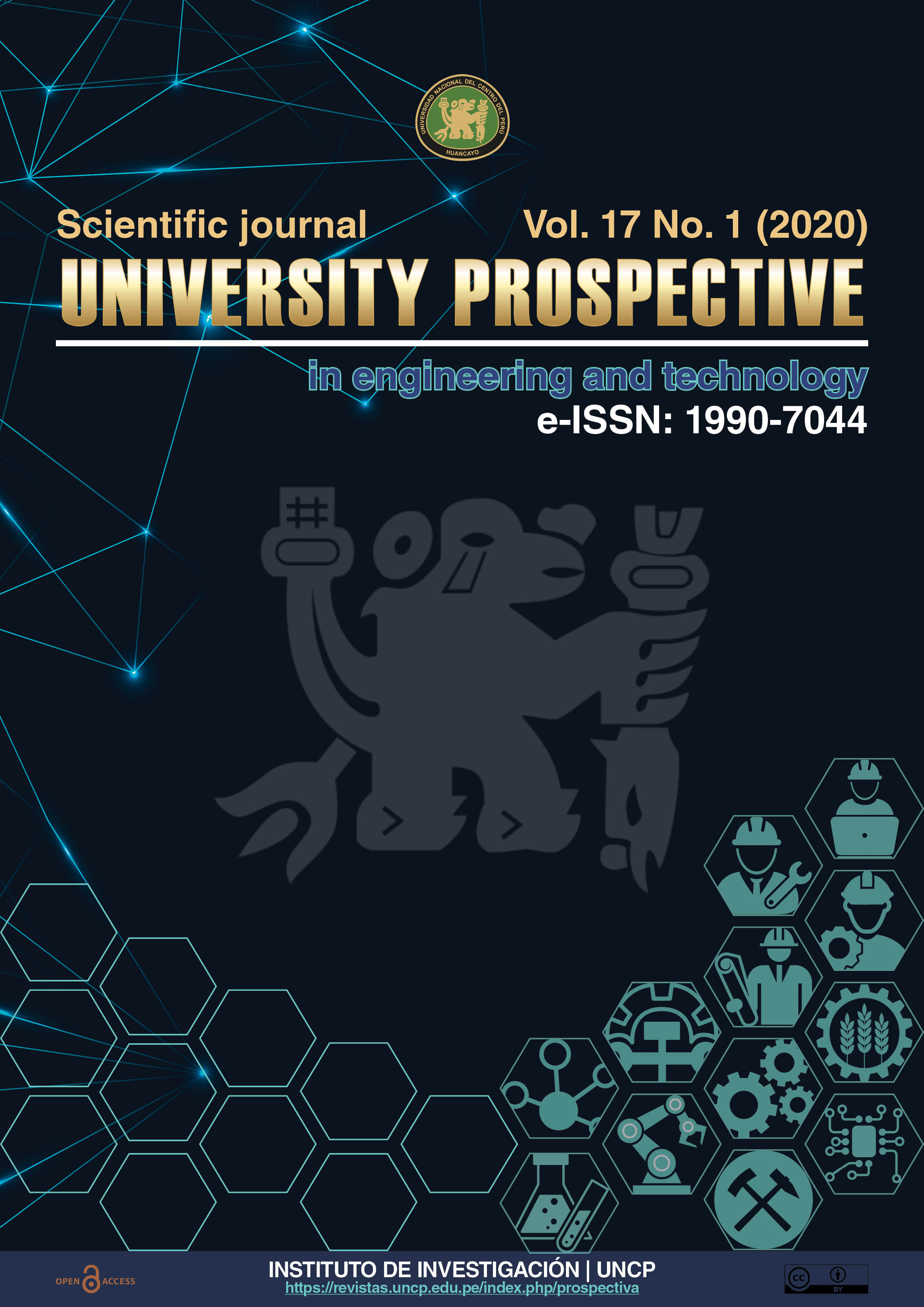Cavitation control to obtain optimal operating parameters in centrifugal pumps
DOI:
https://doi.org/10.26490/uncp.prospectivauniversitaria.2020.17.1403Keywords:
Cavitation control, Cavitation, Cavitation in pumps, Cavitation parameters, Centrifugal pumpsAbstract
In this research work we try to describe the variables that influence cavitation in centrifugal pumps with the objective of controlling cavitation to obtain the optimal operating parameters in centrifugal pumps developed in the hydraulic machines laboratory of the Faculty of Engineering. Mechanics of the National University of the Center of Peru. Cavitation is one of the permanent problems that occurs in hydraulic system installations, which consists of the formation of bubbles in the steam due to a depression below the saturation point of the water. The research carried out is of the experimental and applicative type, whose data collection was carried out in the module of a recirculation pumping system that consists of a Pedrollo brand centrifugal pump with 0.5HP power, Hmax. = 40 m, Qmax = 40 l/min and 1” transparent PVC conduction pipes, where the data was taken to perform the NPSH calculations. The result of the research work consists of characterizing the variation of the suction level that directly influenced the NPSHR and NPSHD so that the higher the flow rate has the tendency to increase and decrease this parameter respectively, objectively verifying the foundamental that Mataix (1976) supports.
Downloads
References
Balcázar Cruz, F. (2013), Análisis de las variables de la cavitación en bombas centrífugas horizontales, tesis de grado de Ingeniero mecánico, Instituto Politécnico Nacional, Unidad Azcapotzalco, Mexico.
De Souza, Z., (1991), Dimensionamiento de máquinas de fluxo, Turbinas, Bombas e Ventiladores, (Editorial E. Blucher; San Pablo.
Fernández Diez P. (1998), “Bombas, Ventiladores y Turbinas Hidráulicas”, Edit. Universidad de Cantabria, Santader.
Carcía M. A. (2011), Turbomáquinas: Turbinas hidráulicas, Universidad Nacional del Callao, facultad de ingeniería eléctrica y electrónica. Lima, Editorial IIUNAC. https://unac.edu.pe/images/documentos/.../vri/.../IF.
Gardea Villegas H. (1992) “Aprovechamientos Hidroeléctricos y de Bombeo”, Edit
González, V. (1991), Hidráulica, Bombas y Compresores, (Editorial Pueblo y Educación, Ciudad de la Habana.
Karassik., J. I. (1981), Factores Hidráulicos del sistema, (Hydraulic Institute Standards, New York).
Karelin, B. I. (1975), Fenómeno de Cavitación en Bombas Centrífugas y Axiales, (Mashinostroenve, Moscú).
Mataix Claudio, (1976) “Mecánica de fluidos y máquinas hidráulicas”, Edit. Harla, España.
Normas Técnicas Brasileira ABNT/NBR-10131, (1987), Bombas hidráulicas de fluxo, (Terminología, Rio de Janeiro, p. 25).
Ramos, N. (1994), Bombas, Ventiladores y Compresores, (Editora ISPJAE, Ciudad de la Habana).
Pérez, B. R. (2004), Cavitación y materiales de construcción en las Bombas Centrífugas, Revista Minería y Geología.
Pérez, B. R. (2004), Procedimiento para evaluar y seleccionar Bombas Centrífugas, Revista Minería y Geología.
Reyes, D. J. (2007), Diagnóstico de instalaciones de transporte de hidromezcla afectadas por cavitación, Revista Minería y Geología.
Salazar Merino Jorge, (2015), Diseño de bombas centrífugas, Tesis. UNI. Lima- Perú
Sierra Bravo (2001), Metodología de la investigación, Internacional S.T. , Mexico
Downloads
Published
Issue
Section
License
Copyright (c) 2020 Edmundo Muñico Casas

This work is licensed under a Creative Commons Attribution-NonCommercial-ShareAlike 4.0 International License.
Esta Revista es de acceso abierto a su contenido a través del Internet, poniendo a disposición de la comunidad científica los resultados de la investigación, de manera gratuita, para el intercambio del conocimiento desarrollado.
El contenidos de la Revista se distribuyen bajo la licencia Creative Commons Reconocimiento-NoComercial-CompartirIgual 4.0 Internacional.
![IconJournalPU [ENG] by Edgar Julian-Laime®](https://revistas.uncp.edu.pe/public/journals/1/pageHeaderLogoImage_en.png)









